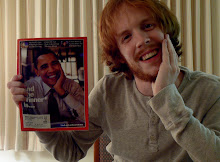
In film class the other day, my insructor Lise was discussing the emergence of psycho-analytical film readings in the 1940s and 50s. She then mentioned that two of the fastest-growing areas film-studies: Queer & Colonial. In other words, we can look back at the filmographies of the geratest directors of all time and re-read these fims from a queer angle or from an anti or pro-colonial stance.
That said, I have always been a fan of a queer reading of cinema. Afterall, Hollywood has always been a little bit more densely populated by the gays than most other fields of work. So, I watched Paranoid Park tonight, and I am really psyched both that my streak of great films remains uninterrupted, and that I have a brand-new exmple of barely-disguised queer cinema to discuss.
So, Paranoid Park tells the story of a young skater who might've sorta killed a dude. Its directed by Gus Van Sant, and is apparently his first art film sicne completing the Death Trilogy (Elephant, Gerry, and Last Days). Now, I've loved Van Sant's Elephant since the film was released, I listed it as my favorite Van Sant film. However, after watching Paranoid Park, I would have to say that my mind has almost changed. And that is saying something.
Reading over the IMDb comments for the film, I immediately encountered a comparison to Camus' The Stranger. While the commenter specified that the film resmbled the book in tone not plot, I would argue the opposite. I would say that the film tells the basic story of The Stranger, except because the central characters are fundamentally different (the protagonist of Paranoid Park is not exactly nonchalant about the whole ordeal), we see the plot cut in half.
I think that the most apt reading of the film is with a homoerotic subtext. While Van Sant's film's have always embraced handsome male characters, much of his recent work (specifically this flm and Elephant) have employed androgynous male teens as the audience's surrogate, and this film especially seems to legitamize the queer subtextual reading of Van Sant's ouvre.
Where is the homoerotic subtext in this film you ask? Geez. Where to start? Well, the film's baby-faced main character is constantly day-dreaming about slightly older boys gliding through the air in slow motion, their backsides in special focus. Many times, these skateboarding reveries (shot on grainy handheld film, in the style of actual skate videos...an aesthetic that Van Sant wisely explores throughout the film) are accompanied by narration that can easily be read as a sort of sexual awakening. The young protagonst is constantly talking about his fascination and reverence of the older skate punks at Paranoid Park, and he dumps his girlfriend after she basically pressures him into having sex for the first time with her.
One scene that highlights the homoerotic subtext of the story in particular is approached in a Rashoman-like format. The first time we see it played through, we are introduced to a group of older homeless skate punks who seem to take a liking to our anti-hero Alex. After they invite him out "for some beers," one older guy seems to eye Alex with a predatory glance, and he explains that while he was unsure of drinking, he couldn't resist "jumping boxcars" with this handsome mysterious man.
The first time we see this scene played through, we immediately cut to a shot of Alex quickly undressing himself in an empty room, taking a shower, and then finding himself too emotonally distraught to call an unnamed somebody. It seem that this scene has been set up to lead the viewer to assume that a sxual liason has occured. However, later in the film, we learn that the strange gap in time actually contains the accidental murder at the plot's center.
So, if we were to just ignore the second edition of the scene, and acknowledge that SOMETHING happened in the boxcars between Alex and the handsome older gentleman, the murder becomes completely irrelevant...and the movie still works. Alex walks around with paranoia, shame, guilt, and ultimately a small relief, this could be the result of the discovery of his homosexuality if the context was tweaked just slightly.
The entire film, Alex discusses his girlfriend with a vague sense of disgust, and expresses to the audience through narration his extreme anxieties about the possibility that she may want to have sex with him. When they finally do have sex, she asks afterward "Should we do it again, or should we wait?" Alex just lies, expressionless on the bed.
These scenes play around with gender roles and expectations far too much to be ignored in any reading of the film, let alone a queer reading.
However, I would argue that a queer reading is really the dominant reading of the film. With the staggered plot progression - broken up by the film's narrative gimmick of having Alex be writing the story down as a confession - the murder and escape or over within a half-an-hour into the film. The real meat of the film lies in Alex's face, which must take up about 88% of the film's running time. Van Sant has the camera study Alex's blank face the same way Bergman observed Ullman's in Persona.
To be clear, I am in no way implying pedastray - on the contrary, I find Van Sant's treatment of of Alex to be far from exploitative - but I would definitely argue that the film's fascination with the physical nature of skateboarding, paired with the somewhat allegorical homoerotic reading of the film, cannot be ignored when assessing its direct meanings.
In the end, Van Sant continues to be one of the most worthwhile modern directors to get invested in, rain or shine. In this case, the sun is almost brighter thn ever,
Nathaniel Tyson

No comments:
Post a Comment